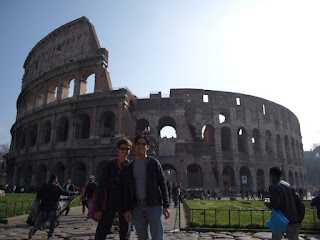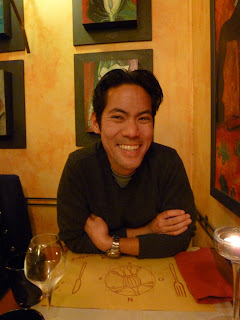I can't help it...I cannot call these museums by their translated-to-English names. The Italian is just so smooth, and rolling - and it sounds so comfortingly similar to Spanish to me, that I simply can't title the post "The National Archaeology Museum of Naples" - which just sounds pointy and brusque. Do you feel that? Well, even if you can't, cognates rule, and obviously you're brilliant (as evidenced by the fact that you're reading our blog!), so we trust that you can figure things out.
So: Naples. Kee-Min has already described our late-night arrival in Naples, our initial impressions of the city (or at least, the area near the train station), and our first meal. But the more pressing question: Why Naples? Almost everyone we consulted while planning our trip advised against visiting Naples - so why did we flagrantly ignore this repeated advice? There were three reasons, really:
1. First of all, books. In the autobiography Eat, Pray, Love, author Elizabeth Gilbert says this:
"I instantly love Naples. Wild, raucous, noisy, dirty, balls-out Naples. An anthill inside a rabbit warren, with all the exoticism of a Middle Eastern bazaar and a touch of New Orleans voodoo. A tripped-out, dangerous, and cheerful nuthouse."
I'll admit - I was intrigued. I'm not a city girl, and there was no earthly reason I should like what is being described here. Blame the power of the pen, but Gilbert's description made me so curious, that I couldn't imagine going to Italy and not visiting Naples. The deal was sealed when I read John Grisham's Playing for Pizza while we were in the throes of trip planning. The book is set in Naples, and the cast of characters are basically a rag-tag group of football-playing locals. Throughout the story, they prove themselves to be independent, loyal, and passionate - about football, about food & drink, and about family & friends. How could I not want to meet them?
2. Our culinary tour of Italy could hardly be complete without tasting the infamous Neopolitan pizza!
3. I wanted desperately to visit and hike Mount Vesuvius. I guess that our Mount Ngauruhoe adventure didn't quite rid me of all mountain-climbing desires. Crazy girl...
Our Vesuvius visit was still a day or two away, but several guidebooks had suggested preparing with a stop at the Museo Archeologico, where many of the artifacts excavated from Pompeii and Herculaneum (the two main cities blanketed in volcanic debris when Vesuvius erupted) are on display. So, that's where we headed.
On our way, we passed the Duomo di San Gennaro, probably the most famous cathedral in Naples. The beautiful, huge structure was incongruous, surrounded on both sides and across the street by deserted/drab/dirty storefronts.
For a better perspective on size, check out the size of the door versus the height of the people in this one:
We stopped in, briefly, to gawk at the gilt wooden ceiling, chapels, statues, and frescoes. But our visit was cut short when we were unceremoniously ushered out by a guard. Good to know he doesn't let tourists interfere with his lunch break!
We grabbed our own lunch, but you'll have to stop back in a day or two for The Great Pizza Showdown: Naples Edition. [Subsequent blogging on pizza is here.] Finally, we made it to the Museo Archeologico.
This was probably the least organized and least English-friendly museum we visited. Almost all of the placards are exclusively in Italian, with the exception of a small collection of displays for kids, which are in both Italian and English. Nor was the museum particularly well-kept. The displays are dusty, and the whole place looks a bit worn out.
But even these language and cosmetic challenges didn't detract from the Herculaneum/Pompeii artifacts. They were largely self explanatory, so language didn't prove too much of a barrier to our enjoyment and appreciation of them. But what was most amazing was how well they were preserved - almost everything was in excellent condition, and I had trouble believing that it was all nearly 2,000 years old. The collection included pretty much anything you could need or want to create a home - from kitchenware to lanterns to coins to jewelry, nearly all in pristine condition.
We also spent quite some time oogling the museum's impressive collection of mosaic displays, also from Herculaneum and Pompeii. The mosaics ranged in size from small plate decorations, to huge displays that occupied an entire wall. In the far corner of the museum, past all the mosaic displays, we stumbled upon the "Secret Cabinet", a collection of Roman erotica from Pompeii. The history of the room is pretty funny (thankfully, this was available in English), as it apparently caused quite a bit of controversy when it first opened. Nowadays, the museum's policy is that only visitors over the age of 11 are permitted. Not that anyone was checking IDs...
After watching a dozen Japanese tourists snapping photos of every
exhibit in the mosaic collection, we realized that the Italian's enforcement
of the "No Photography" policy is similar to the Greek's: No enforcement (We discuss Greece's policy here). So, when we made it down to the collection of Greek and Roman sculptures on the ground floor, we finally took out our cameras. Many of the statues in this collection once stood somewhere in Rome (the one below was in the Bath of Caracalla, for example), and were later housed at the Farnese Palace. Now on display at the museum, they are known as the "Farnese Collection".
 |
| The Farnese Bull [The original was probably from the 1st or 2nd century BC. This is a replica from the 3rd century AD.] |
The stories behind some of these statues are not for the faint of heart. The Farnese Bull, for example, depicts two young men tying Queen Dirce to a raging bull, as punishment for her mistreatment of their mother. Warm and fuzzy, right?
 |
| Stanley and I posed in this photo for some perspective - these statue were enormous |
| Now, the photo above looks pretty benign, right? Well - don't underestimate our ability to cause trouble in Italian museums! [If you recall, we inadvertently started a bit of a ruckus trying to find the Cafe at the Musei Capitolini in Rome.] By now, it was near closing time for the museum. The school groups had gone home, as had most of the other visitors, and we were basically alone in the statue wing of the museum. Alone, except for a single museum attendant stationed at one end of the room. She fiddled, fidgeted, yawned, looked exceptionally bored, and eventually wound up pacing the room while talking on her cell phone, as we wandered around and took photos. She didn't seem to care, or even pay us one bit of attention. Eventually, I remembered Stanley, and whipped him out for a quick photo shoot. My initial concept for the photo was to place Stanley at the statue's foot, to provide a very clear comparison of sizes. So, I placed this (small, clean, paper) Stanley on the marble at his foot. Well, that museum attendant must have had "someone touched a statue"-dar, because the next thing I knew, she was in super-motion. She sprinted toward us, waving her arms and yelling. Apparently, (small, clean, paper) Stanleys aren't allowed to touch the marble. Good to know. Clearly, she was only doing her job (very thoroughly, at that), but that pretty much sealed the deal for us - we were ready to go. We skipped the last few rooms, collected our belongings from the Coat Check, and headed back out into the crazy world of Naples. After all, there was pizza to be eaten! |



































